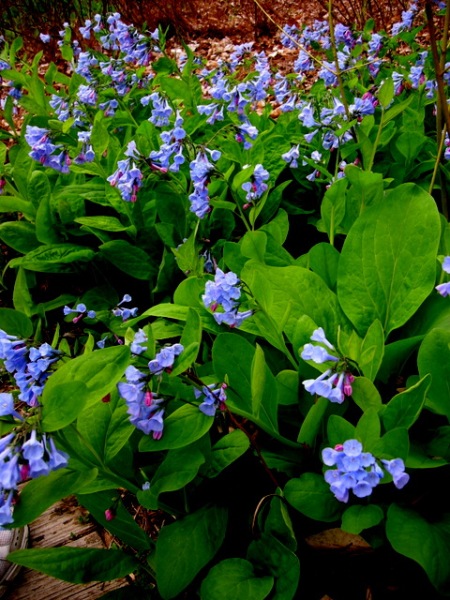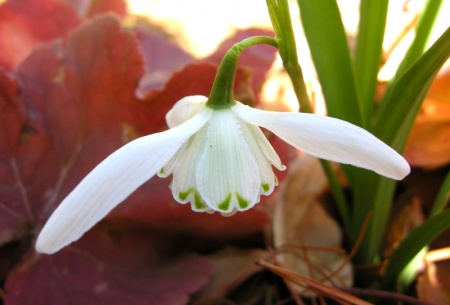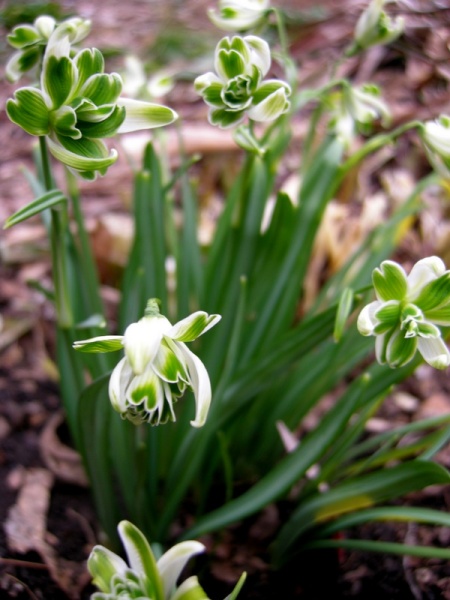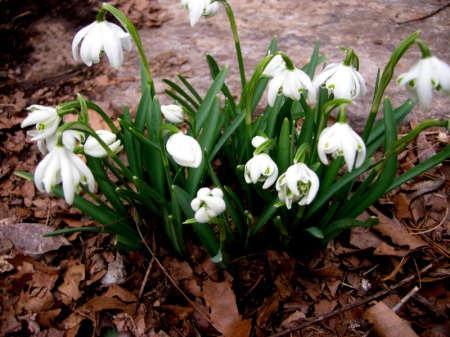 Corydalis solida comes in many colors: in the right corner is ‘Purple Bird’, in the middle is pink ‘Beth Evans’, and in the left corner is brick red ‘George P. Baker’.
Corydalis solida comes in many colors: in the right corner is ‘Purple Bird’, in the middle is pink ‘Beth Evans’, and in the left corner is brick red ‘George P. Baker’.
As the hellebores bloom in my garden, they do not stand alone but are surrounded by large swathes of spring ephemerals. These are plants that come up in the spring to take advantage of the available sun before the leaves come out and then go dormant for the year as it gets hot. I especially appreciate their vibrant colors at a time of year when spring is here, but the weather is not necessarily warm and sunny.
Nursery News: Carolyn’s Shade Gardens is a retail nursery located in Bryn Mawr, PA, specializing in showy, colorful, and unusual plants for shade. The only plants that we ship are snowdrops and miniature hostas. For catalogues and announcements of events, please send your full name, location, and phone number (for back up use only) to carolyn@carolynsshadegardens.com. Click here to get to the home page of our website for catalogues and information about our nursery and to subscribe to our blog.
.
All the plants shown here are in bloom now or just about to bloom. They are very easy to plant and grow. And best of all they spread by themselves to form large patches in the years after you plant them. Spring ephemerals don’t take up any room as they can be interplanted with hostas, ferns, and other perennials that come up later and fill in the space. They are also great for the backs of beds that are empty and visible before other plants emerge.
.
 This riot of color is going on in my woods right now as various shades of Corydalis solida bloom with hellebores.
This riot of color is going on in my woods right now as various shades of Corydalis solida bloom with hellebores.
Here are some more suggestions for plants that will achieve this early spring bounty in your garden—all available at Carolyn’s Shade Gardens this weekend:
.
 Snow crocus, C. tommasinianus, bloom with the snowdrops, and you can’t beat the color of ‘Ruby Giant’.
Snow crocus, C. tommasinianus, bloom with the snowdrops, and you can’t beat the color of ‘Ruby Giant’.
.
 ‘Ruby Giant’ with white hellebores, a match made in heaven.
‘Ruby Giant’ with white hellebores, a match made in heaven.
.
 Pale blue squill, Scilla mischtschenkoana, is the earliest blooming of the group, here with Dutchman’s breeches.
Pale blue squill, Scilla mischtschenkoana, is the earliest blooming of the group, here with Dutchman’s breeches.
.
 Winter aconite, Eranthis hyemalis, blooms with the snowdrops.
Winter aconite, Eranthis hyemalis, blooms with the snowdrops.
.
 Snowdrops and winter aconite are the most beautiful sight in my late winter garden.
Snowdrops and winter aconite are the most beautiful sight in my late winter garden.
.
 After it blooms, winter aconite’s elegant foliage makes a great backdrop for hellebores and Corydalis solida.
After it blooms, winter aconite’s elegant foliage makes a great backdrop for hellebores and Corydalis solida.
.
 As the pale blue squill fades, striped-squill, Puschkinia scilloides, takes over.
As the pale blue squill fades, striped-squill, Puschkinia scilloides, takes over.
.
 Striped-squill has naturalized to form a large patch under my winter hazel.
Striped-squill has naturalized to form a large patch under my winter hazel.
.
 Also coming into bloom now are the fluorescent blue flowers of Siberian squill, Scilla siberica.
Also coming into bloom now are the fluorescent blue flowers of Siberian squill, Scilla siberica.
.
 Siberian squill has moved all over my garden and has never appeared anywhere that I didn’t want it. The color is just gorgeous.
Siberian squill has moved all over my garden and has never appeared anywhere that I didn’t want it. The color is just gorgeous.
.
 Checkered lily, Fritillaria meleagris, is just getting started. It too seeds to spread through out my woods.
Checkered lily, Fritillaria meleagris, is just getting started. It too seeds to spread through out my woods.
.
 Glory-of-the-snow, Chionodoxa forbesii, has lovely upturned blue flowers with an ethereal white center. Here it peeks through the winter leaves of native ‘Caramel’ heuchera.
Glory-of-the-snow, Chionodoxa forbesii, has lovely upturned blue flowers with an ethereal white center. Here it peeks through the winter leaves of native ‘Caramel’ heuchera.
.
 Glory-of-the-snow spreads quickly to form large patches. It looks especially beautiful under my star magnolia right now.
Glory-of-the-snow spreads quickly to form large patches. It looks especially beautiful under my star magnolia right now.
.
 The lovely leaves of U.S. native dogtooth violets, Erythronium, are appearing now and the earliest varieties are blooming. Although they look delicate, they are as tough as nails and come back in my woodland year after year.
The lovely leaves of U.S. native dogtooth violets, Erythronium, are appearing now and the earliest varieties are blooming. Although they look delicate, they are as tough as nails and come back in my woodland year after year.
.
 I can see the dark purple leaves of native Virginia bluebells, Mertensia virginica, emerging from the mulch. I can’t get enough of its porcelain blue flowers, here with native Celandine poppy.
I can see the dark purple leaves of native Virginia bluebells, Mertensia virginica, emerging from the mulch. I can’t get enough of its porcelain blue flowers, here with native Celandine poppy.
.
 European wood anemones are also getting ready to pop. The earliest is yellow-flowered Anemone ranunculoides, but they also come in pink and white.
European wood anemones are also getting ready to pop. The earliest is yellow-flowered Anemone ranunculoides, but they also come in pink and white.
.
 ‘Wyatt’s Pink’ European wood anemone is quite rare and beautiful.
‘Wyatt’s Pink’ European wood anemone is quite rare and beautiful.
.
 The elegant flower of ‘Bractiata’ European wood anemone.
The elegant flower of ‘Bractiata’ European wood anemone.
.
All these flowers keep me going through the cold wet days of early spring. Add them to your own garden to beat the winter doldrums and signal that the end is in sight.
Carolyn
Nursery Happenings: Our first event is the Hellebore Extravaganza this Saturday, April 11, from 10 am to 3 pm. However, you can stop by anytime by appointment to purchase hellebores and other plants.
Carolyn’s Shade Gardens is a local retail nursery in Bryn Mawr, Pennsylvania, U.S., zone 6b/7a. The only plants that we mail order are snowdrops and miniature hostas and only within the US.
If you are within visiting distance and would like to receive catalogues and information about customer events, please send your full name and phone number to carolynsshadegardens@verizon.net. Subscribing to my blog does not sign you up to receive this information.
Facebook: Carolyn’s Shade Gardens has a Facebook Page where I post single photos, garden tips, and other information that doesn’t fit into a blog post. You can look at my Facebook page here or click the Like button on my right sidebar here.
Notes: Every word that appears in orange on my blog is a link that you can click for more information. If you want to return to my blog’s homepage to access the sidebar information (catalogues, previous articles, etc.) or to subscribe to my blog, just click here.

















































